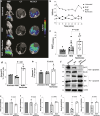Proapoptotic Bcl-2 inhibitor as potential host directed therapy for pulmonary tuberculosis
- PMID: 40148277
- PMCID: PMC11950383
- DOI: 10.1038/s41467-025-58190-x
Proapoptotic Bcl-2 inhibitor as potential host directed therapy for pulmonary tuberculosis
Abstract
Mycobacterium tuberculosis establishes within host cells by inducing anti-apoptotic Bcl-2 family proteins, triggering necrosis, inflammation, and fibrosis. Here, we demonstrate that navitoclax, an orally bioavailable, small-molecule Bcl-2 inhibitor, significantly improves pulmonary tuberculosis (TB) treatments as a host-directed therapy. Addition of navitoclax to standard TB treatments at human equipotent dosing in mouse models of TB, inhibits Bcl-2 expression, leading to improved bacterial clearance, reduced tissue necrosis, fibrosis and decreased extrapulmonary bacterial dissemination. Using immunohistochemistry and flow cytometry, we show that navitoclax induces apoptosis in several immune cells, including CD68+ and CD11b+ cells. Finally, positron emission tomography (PET) in live animals using clinically translatable biomarkers for apoptosis (18F-ICMT-11) and fibrosis (18F-FAPI-74), demonstrates that navitoclax significantly increases apoptosis and reduces fibrosis in pulmonary tissues, which are confirmed in postmortem analysis. Our studies suggest that proapoptotic drugs such as navitoclax can potentially improve pulmonary TB treatments, reduce lung damage / fibrosis and may be protective against post-TB lung disease.
© 2025. The Author(s).
Conflict of interest statement
Competing interests: The authors declare no competing interests.
Figures






Update of
-
Proapoptotic Bcl-2 inhibitor as host directed therapy for pulmonary tuberculosis.Res Sq [Preprint]. 2024 Sep 2:rs.3.rs-4926508. doi: 10.21203/rs.3.rs-4926508/v1. Res Sq. 2024. Update in: Nat Commun. 2025 Mar 27;16(1):3003. doi: 10.1038/s41467-025-58190-x. PMID: 39281866 Free PMC article. Updated. Preprint.
References
-
- WHO. Global Tuberculosis Report (2024).
-
- Malik, Z. A., Iyer, S. S. & Kusner, D. J. Mycobacterium tuberculosis phagosomes exhibit altered calmodulin-dependent signal transduction: contribution to inhibition of phagosome-lysosome fusion and intracellular survival in human macrophages. J. Immunol.166, 3392–3401 (2001). - PubMed
-
- Aguiló, N., Marinova, D. & Martín, C. J. P. ESX-1-induced apoptosis is involved in cell-to-cell spread of Mycobacterium tuberculosis. Cell Microbiol. 15, 1994–2005 (2013). - PubMed
MeSH terms
Substances
Grants and funding
- S10 OD030381/OD/NIH HHS/United States
- R01 AI153349/AI/NIAID NIH HHS/United States
- R56 AI179012/AI/NIAID NIH HHS/United States
- R01-AI153349/U.S. Department of Health & Human Services | NIH | National Institute of Allergy and Infectious Diseases (NIAID)
- R01 AI190038/AI/NIAID NIH HHS/United States
- S10 OD032154/OD/NIH HHS/United States
- S10-OD030381-A1/U.S. Department of Health & Human Services | NIH | NIH Office of the Director (OD)
- R01 AI145435/AI/NIAID NIH HHS/United States
- R01-AI145435-A1/U.S. Department of Health & Human Services | NIH | National Institute of Allergy and Infectious Diseases (NIAID)
- R56-AI179012-A1/U.S. Department of Health & Human Services | NIH | National Institute of Allergy and Infectious Diseases (NIAID)
- R01-AI190038/U.S. Department of Health & Human Services | NIH | National Institute of Allergy and Infectious Diseases (NIAID)
LinkOut - more resources
Full Text Sources
Research Materials

